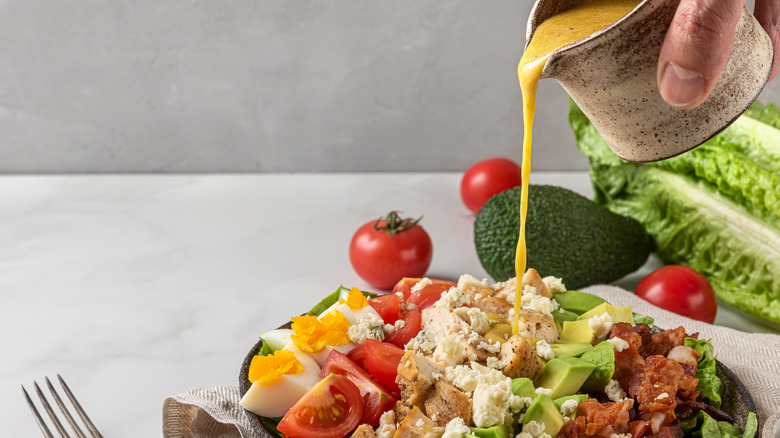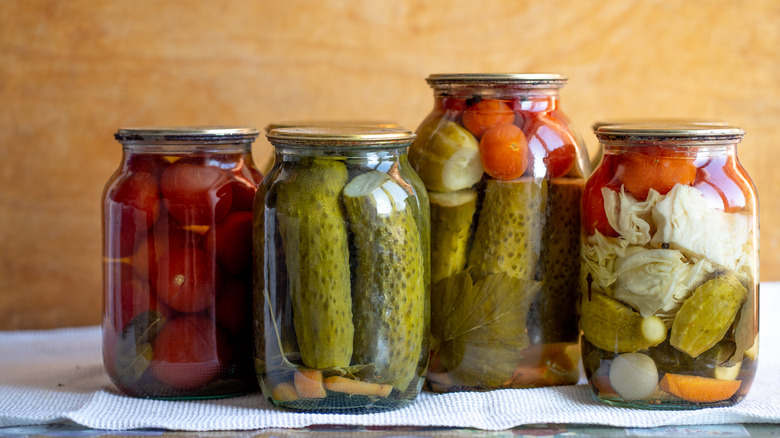The Unexpected Ingredient Curtis Stone Adds To His Salad Dressing
Chefs love their secret ingredients. It makes sense that when you cook for a living, you have access to a wide range of materials with which to experiment — and with such artistic license, you're bound to come across additions that become trademarks. The Pioneer Woman Ree Drummond has her Cholula hot sauce, Bobby Flay keeps fishy anchovies in his arsenal, and the famous Julia Child worked dark sesame oil into her crêpes, of all things. Australian chef and family guy Curtis Stone of culinary television fame — who had his "first, truly memorable food experience" at a mere 4 years old according to his website — is no exception.
Chef Stone has something special up his sleeve when it comes to making homemade salad dressing, and so should you. Making your own salad dressing is not just something chefs do because they're chefs — it's easy to do and might just earn you some celebrity chef recognition of your own among the people you cook for. It might surprise you to learn that pouring oil and vinegar over greens was practiced by ancient Babylonians and Egyptians, according to The Association for Dressings and Sauces, but it was really the nobles and royalty who cornered the market on creamy dressings. So why not make a name for yourself and learn Chef Stone's trick?
The Take Home Chef's secret salad ingredient
Hint: You probably already have it in your home. In an interview with EatingWell, Curtis Stone said he adds the liquid from pickled vegetables to his homemade salad dressing recipes, praising its versatility and all-in-one flavor. Some pickles are sweet; others are more on the briny side, and you'll have an acidic tartness without having to hunt down your sugar, salt, and vinegar. Don't stop at pickled cucumbers — beets, dilly beans, pepperoncini peppers, and giardiniera are all fair game.
Pickle juice has been touted as everything from a muscle cramp/dehydration reliever (per Healthline), and an unexpected BFF of whiskey (per Atlas Obscura). But realistically, most of us know it as what's leftover in the jar after you've snacked on all the crunchy veggies within. We bet you have a pickle-less jar of brine forgotten in your fridge door that's patiently waiting to heed your call and make your next salad shine like Stone's. You can also use it to make a pickled egg recipe or brine some chicken.
Why make your own salad dressing?
There are plenty of store-bought, ready-made dressings out there, from ranch to Italian, green goddess and Thousand Island, and everything in between. Their origins are often rooted in restaurants' selling their signature dressings to diners, according to The Association for Dressings and Sauces. But many bottled salad dressings contain high amounts of fat, sugar, and calories, warns Harvard Medical School, kind of defeating the purpose of opting for a salad in the first place. Making your own dressing is healthier, and cheaper — you'll likely be hooked once you get the hang of it. It's fun, too: Make it in a mason jar, shake it up, and keep it in the fridge for all your food seasoning and marinating needs.
Plus, making your own dressing from pickle juice cuts down on food waste, promotes a thrifty "use it all up" approach to cooking, and gives you a phenomenal product to gift to your foodie friends and family. It might just be time to find that long-lost pickle jar and give it a new purpose.


